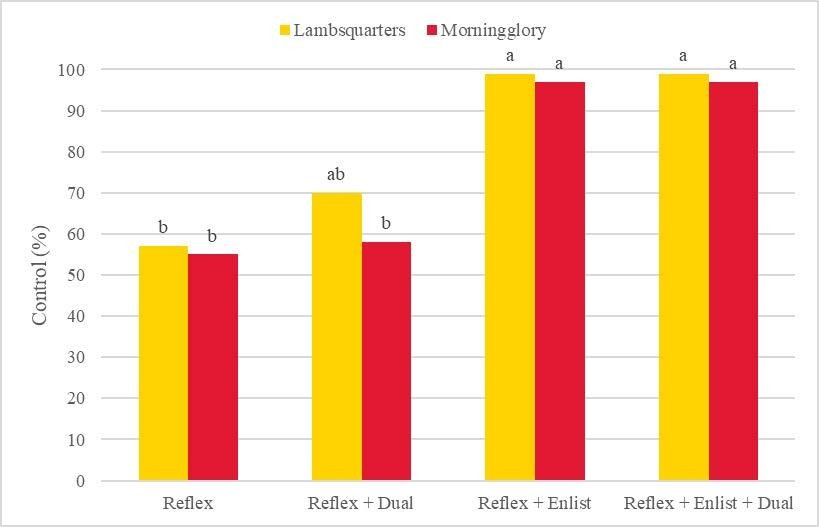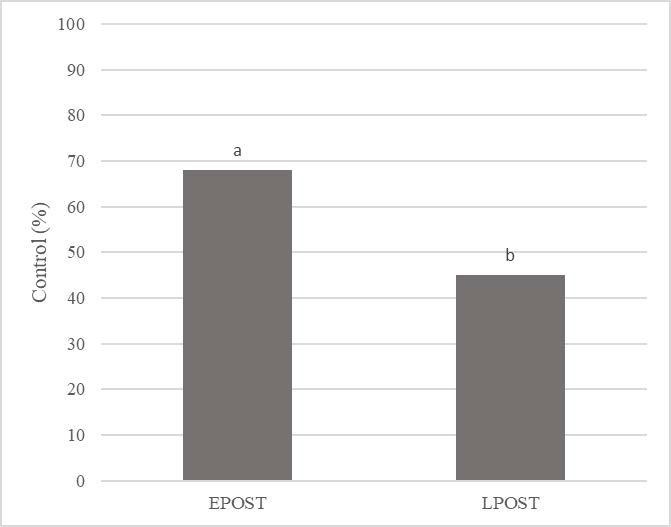Assessing Herbicide Tank Mixes for Postemergence Weed Control in Soybean

Research was conducted at the Wye Research and Education Center to evaluate herbicide tank mixes for postemergence weed control in herbicide-tolerant soybean. As herbicide-resistant weeds continue to drive weed management decisions, options are needed to not only provide effective weed control, but also preserve the value of available herbicides.
Tank mixing multiple, effective herbicide groups is one tactic that can be used to impede herbicide resistance. By including multiple, effective herbicide groups when making an application, there is a lower probability that a weed species will develop resistance to all herbicides used (Fig. 1). Furthermore, tank-mixing different herbicide groups can have a synergistic effect, where the combined effect of two or more groups is greater than the effects of each herbicide alone. For example, previous research has shown Enlist One + Liberty to be more effective in controlling as common ragweed and Palmer amaranth, compared to each individual herbicide.
This research examined the effectiveness of tank mixing of herbicides with foliar (2,4-D, fomesafen) and residual (fomesafen, S-metolachlor) for early and late postemergence weed control in soybean. Plots (10 ft. x 25 ft.) were arranged in a randomized complete block design with 4 replicates. Herbicide treatments consisted of applying Reflex (fomesafen), Reflex + Dual Magnum (S-metolachlor), Reflex + Enlist One (2,4-D) or a three way mix of Reflex + Dual + Enlist One (Table 1). The entire study area received 1 pt/A Dual Magnum within 24 hours of soybean planting Enlist E3 soybeans on June 4, 2024. Early postemergence (EPOST) applications were made 2 weeks after planting and late postemergence (LPOST) applications 4 weeks after planting.
| Herbicide(s) | Rate | Timingᵃ |
|---|---|---|
| Reflex | 1.5 pt | EPOST or LPOST |
| Reflex + Dual | 1.5 pt + 1.5 pt | EPOST or LPOST |
| Reflex + Enlist | 1.5 pt + 2 pt | EPOST or LPOST |
| Reflex + Enlist + Dual | 1.5 pt + 2 pt + 1.5 pt | EPOST or LPOST |
ᵃ Herbicide treatments were applied early postemergence (EPOST) 2 weeks after planting or late postemergence (LPOST) 4 weeks after planting soybeans on June 4, 2024.
Broadleaf Weed Control
Application timing did not affect common lambsquarters or morningglory control. Reflex + Enlist or Reflex + Enlist + Dual controlled common lambsquarters better compared to Reflex alone, and morningglory species better than Reflex or Reflex + Dual (Fig. 2).
Applications made EPOST provided better control compared to applications made LPOST (Fig. 2), but giant foxtail control varied from 38% to 78%, with no significant differences among herbicide treatments (Fig. 3). It should be noted that Enlist One does not control grasses. Both Dual Magnum and Reflex can provide some grass activity, but only if applied PRE. Better foxtail control with EPOST treatments could be attributed to overlapping residual control with these treatments. Overlapping herbicides is a tactic that involves sequential applications of herbicides with soil-residual activity to lengthen herbicidal activity before the first herbicide dissipates. As Dual Magnum was included in both PRE and POST applications, the EPOST applications likely provided better overlapping residual control due a shorter application window between the PRE and POST applications (2 weeks for EPOST and 4 weeks for LPOST).
This research highlights the value of adding multiple herbicide groups to the tank at the time of POST applications (Fig. 4). While additional work is needed to confirm the results of this study, the following factors should be considered when deciding which herbicides to include in the tank:
- The types of weeds are prevalent in the field. Should the spray program focus primarily on broadleaf weeds, grasses, or both?
- The emergence period for the weeds being controlled. Will a single POST application negate the need for additional treatment, or should an herbicide with residual activity be included?
- Each herbicide must be effective alone on the target weed. Including multiple herbicides will not be as effective if a weed already has significant resistance to one of the herbicides in the mix.
 English
English العربية
العربية Български
Български 简体中文
简体中文 繁體中文
繁體中文 Hrvatski
Hrvatski Čeština
Čeština Dansk
Dansk Nederlands
Nederlands Suomi
Suomi Français
Français Deutsch
Deutsch Ελληνικά
Ελληνικά हिन्दी
हिन्दी Italiano
Italiano 日本語
日本語 한국어
한국어 Norsk bokmål
Norsk bokmål Polski
Polski Português
Português Română
Română Русский
Русский Español
Español Svenska
Svenska Català
Català Filipino
Filipino עִבְרִית
עִבְרִית Bahasa Indonesia
Bahasa Indonesia Latviešu valoda
Latviešu valoda Lietuvių kalba
Lietuvių kalba Српски језик
Српски језик Slovenčina
Slovenčina Slovenščina
Slovenščina Українська
Українська Tiếng Việt
Tiếng Việt Shqip
Shqip Eesti
Eesti Galego
Galego Magyar
Magyar Maltese
Maltese ไทย
ไทย Türkçe
Türkçe فارسی
فارسی Afrikaans
Afrikaans Bahasa Melayu
Bahasa Melayu Kiswahili
Kiswahili Gaeilge
Gaeilge Cymraeg
Cymraeg Беларуская мова
Беларуская мова Íslenska
Íslenska Македонски јазик
Македонски јазик יידיש
יידיש Հայերեն
Հայերեն Azərbaycan dili
Azərbaycan dili Euskara
Euskara ქართული
ქართული Kreyol ayisyen
Kreyol ayisyen اردو
اردو বাংলা
বাংলা Bosanski
Bosanski Cebuano
Cebuano Esperanto
Esperanto ગુજરાતી
ગુજરાતી Harshen Hausa
Harshen Hausa Hmong
Hmong Igbo
Igbo Basa Jawa
Basa Jawa ಕನ್ನಡ
ಕನ್ನಡ ភាសាខ្មែរ
ភាសាខ្មែរ ພາສາລາວ
ພາສາລາວ Latin
Latin Te Reo Māori
Te Reo Māori मराठी
मराठी Монгол
Монгол नेपाली
नेपाली ਪੰਜਾਬੀ
ਪੰਜਾਬੀ Afsoomaali
Afsoomaali தமிழ்
தமிழ் తెలుగు
తెలుగు Yorùbá
Yorùbá Zulu
Zulu ဗမာစာ
ဗမာစာ Chichewa
Chichewa Қазақ тілі
Қазақ тілі Malagasy
Malagasy മലയാളം
മലയാളം සිංහල
සිංහල Sesotho
Sesotho Basa Sunda
Basa Sunda Тоҷикӣ
Тоҷикӣ O‘zbekcha
O‘zbekcha አማርኛ
አማርኛ Corsu
Corsu Ōlelo Hawaiʻi
Ōlelo Hawaiʻi كوردی
كوردی Кыргызча
Кыргызча Lëtzebuergesch
Lëtzebuergesch پښتو
پښتو Samoan
Samoan Gàidhlig
Gàidhlig Shona
Shona سنڌي
سنڌي Frysk
Frysk isiXhosa
isiXhosa

